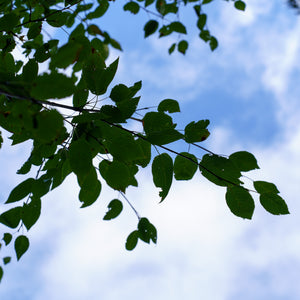The Amelanchier Guide
Amelanchier, commonly known as serviceberry, is a graceful, multi-season small tree or large shrub prized for its spring blooms, edible berries, and brilliant fall foliage. Native to North America, Amelanchier species are a favorite among gardeners and landscape designers for their adaptability, ornamental value, and ecological benefits. From woodland edges to urban gardens, serviceberries add year-round interest and support local pollinators and wildlife.
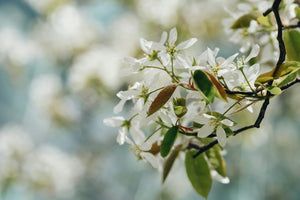
About
Amelanchier belongs to the Rosaceae family and includes species like Amelanchier canadensis, Amelanchier laevis, and Amelanchier arborea. Hybrids such as Amelanchier × grandiflora combine the best traits of parent species, offering improved flowering and growth habits. These deciduous plants are known for their early-spring clusters of white, star-shaped flowers, which are followed by small, blue-black berries and vibrant red to orange fall color.
Cultivars like Amelanchier canadensis 'Autumn Brilliance' and Amelanchier × grandiflora 'Princess Diana' are especially popular for their consistent fall foliage and ornamental shape. Amelanchier laevis 'Cumulus' is prized for its upright habit, making it a strong candidate for street planting or smaller yards.
Serviceberries are valuable not just for their looks but also for their role in the ecosystem. The flowers provide early nectar for pollinators, and the fruit is a favorite among birds and small mammals. Despite their delicate appearance, Amelanchier trees are hardy, resilient, and well-suited to many landscapes.
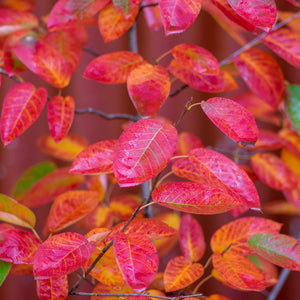
PLANTING
Serviceberry is adaptable to a variety of planting situations, thriving in both formal and naturalistic designs:
- USDA Hardiness Zones: 4–9, depending on species.
- Soil: Moist, well-drained, and slightly acidic soils are preferred, but it can tolerate clay or loam.
- Sunlight: Grows best in full sun to part shade. Full sun encourages better flowering and fruit production.
- Watering: Requires regular watering during establishment. Once established, it is moderately drought-tolerant.
- Spacing: Allow 10–20 feet between trees, depending on the mature width of the cultivar.
- Planting Time: Best planted in spring or fall to allow root development in mild conditions.
When planting bare-root or container-grown Amelanchier, dig a hole twice as wide and as deep as the root ball. Backfill with native soil, water thoroughly, and apply mulch around the base to retain moisture and regulate soil temperature.
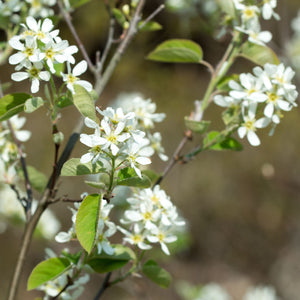
CARE
Amelanchier is relatively low-maintenance, though some care practices will enhance its health and longevity:
- Pruning: Prune after flowering to maintain shape or remove crossing branches. Avoid heavy pruning, as it can reduce flowering.
- Fertilizing: Apply compost or a slow-release balanced fertilizer in early spring if growth appears weak.
- Mulching: Maintain a mulch ring to suppress weeds, retain moisture, and improve soil quality.
- Pests & Diseases: Occasionally affected by rust, fire blight, or leaf miners, though serious issues are rare. Maintain good airflow to prevent fungal disease.

HOW TO USE
Serviceberries are one of the most versatile small trees for residential and commercial landscapes:
- Ornamental Tree: Use Amelanchier x grandiflora 'Robin Hill' or Amelanchier laevis 'Snowflakes' as ornamental focal points in front yards or patios.
- Naturalized Plantings: Blends beautifully with woodland edges, where its seasonal changes complement native underplantings.
- Pollinator Gardens: Pair with viburnum, dogwood, and perennials like echinacea or salvia to attract bees and butterflies.
- Edible Gardens: The berries of Amelanchier canadensis and Amelanchier arborea are edible and can be used for jellies, pies, or eaten fresh.
- Hedgerows or Screening: Multi-stemmed types like Amelanchier canadensis 'Rainbow Pillar' can be planted in groups for informal screens.
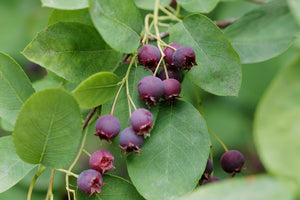
COMMON QUESTIONS
- Are Amelanchier berries edible? Yes, they are edible and have a sweet flavor similar to blueberries. They are enjoyed fresh, cooked, or dried.
- Are Amelanchier toxic to dogs? No, Amelanchier is not known to be toxic to dogs.
- Are Amelanchier toxic to cats? No, it is not considered toxic to cats.
- How fast does Amelanchier grow? Growth rate is moderate, averaging 1–2 feet per year under good conditions.
- How tall do Amelanchier grow? Depending on species, they typically reach 15–25 feet tall.
- When do Amelanchier flower? They flower in early spring, often before or as the leaves emerge.
- When to prune Amelanchier? Prune after flowering to shape or thin the canopy.
- Can you grow Amelanchier in a pot? It is possible for young or dwarf varieties, but large containers and attentive watering are required. Long-term, they are best grown in the ground.
Conclusion
Amelanchier trees offer four seasons of beauty and functionality. From delicate spring blooms to edible summer berries, colorful fall foliage, and attractive winter form, serviceberries are an outstanding addition to landscapes of all sizes. Whether you choose Autumn Brilliance for its fiery leaves or Cumulus for its vertical elegance, Amelanchier rewards gardeners with natural charm and ecological value.
The Amelanchier Collection
Sold Out
Sold Out
Sold Out


